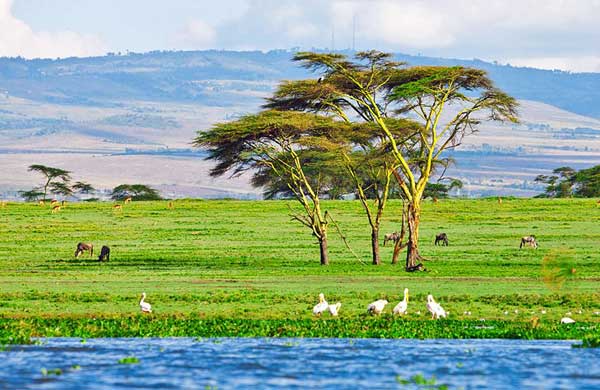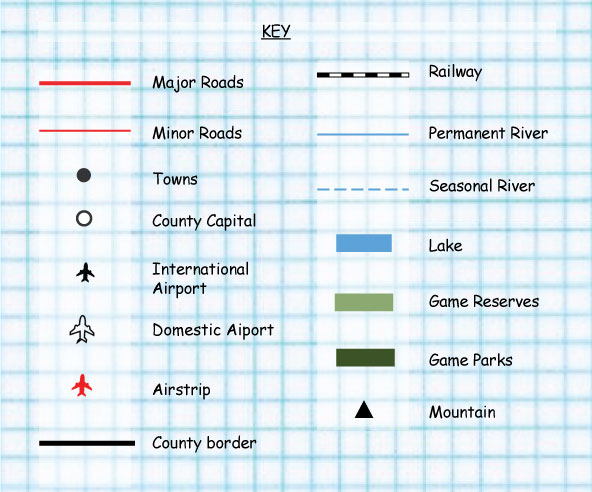Nakuru County
Introduction
Its capital and largest town is Nakuru. Naivasha is another major important urban center in the county.
The county has a population of 1, 503, 325 according to the 2009 census and it has an area of 2, 325.8 km.
It is the fourth largest county in Kenya.

Constituencies
The county has seven constituencies, these are:
- Naivasha
- Nakuru town East
- Nakuru town west
- Kuresoi south
- Kuresoi North
- Molo
- Rongai
- Subukia
- Njoro
- Gilgil
- Bahati
Physical features
Rivers
- The permanent Ngosur River.
- Njoro, Nderit, Makalia and Lamudhiak, all of which originate in the Eastern Mau
Forest
- Mau forest
- African forest
- Menengai Forest
Lakes


- Lake Elementaita (Serena Camp)

Mountains
- Mt. Longonot
- Menengai mountain
- Elementaita Badlands mountain
- Ol Doinyo Eburru mountain
Hills
- Flamingo hill
- Hyrax Hills
Plains
Valleys
Impertance of Physical features
- Features like The Great Rift Valley, lake Naivasha and Elementaita are a big source of revenue to the county government through tourists attraction.
- Forests, Hills, and mountains provide natural habitat for plants, animals and birds and were also considered spiritual places for worship.
Identify the main types of natural vegetation
State the importance of vegetation
- Vegetation is important to the ecosystem of the region
- It also defines the climate of the area
Map of distribution of the physical features.


People and population
The language groups found
Areas of high population density
- Nakuru town and Naivasha town are the most populated regions.
Areas of low population density
- Kamwaura and machege are the least populated towns
Social relations and cultural activities
Traditional way of life of the people
Food
- Traditional Kikuyu food includes githeri (maize and beans), mukimo (mashed green peas and potatoes), roast goat, beef, chicken and cooked green vegetables such as collards, spinach and carrots.
- They prepared and cooked their food in earthen or clay pots, the food is served in wooden plates.
- They used three stones put together and firewood to make fire to cook their food. Kikuyus mainly plant their own food in their gardens (shambas) or their do batter trade with their neighbor’s E.g. the Maasai.
Dressing
- The kikuyu have different types of clothing for different age sets, the clothing are vary from the young to the old.
- Children in the traditional kikuyu tribe wear skins around their waist, they wear no cloth on their upper body.
- Men also wear skins on their waist and walk bare chested but during the cold seasons, the cover themselves up to the knees with shukas.
- Women in the kikuyu tribe have their whole bodies covered with a shuka that is tied on their left shoulder and extends all the way to their ankles.
- They also wear earrings, necklaces, bracelets and anklets that are made from multi-colored beads and cowrie shells.
Songs and dances
- Traditional songs, proverbs and dances bring the myths and legends of the Kikuyu to life. Traditional songs and dances performed at weddings and initiations. Songs are also performed to express simple love and courting songs. Songs are sung when hunting and when going to work in the fields.
Traditional medical practices
- Traditional medicine men and women gathered plants used for medical. Different plants were used to treat different illnesses.
Ceremonies
Naming defer from time to time. Children born during harvest had different names with children born during the dry times. The surname was from the father or the grandfather family. They had elders in the village who was responsible for this process.
Traditionally there was a circumcision ceremony for boys and girls by age grades of about five year periods. All of the men in that circumcision group would take an age grade name. Times in Kikuyu history could be gauged by age grade names. It is thought that the early Thagicu, one of the ancestral groups of the Kikuyu, borrowed this system from Cushitic and Nilotic peoples.
Festivals
This was celebrated with songs and dance. Boys and girls dressed up with feathers and animal skin for the performance. Sacrifice was offered as a way to say thank you to the gods for the good harvest.
Traditional songs and dances performed at weddings and initiations. Songs are also performed to express simple love and courting songs. Songs are sung when hunting and when going to work in the fields.
Resources and economic activities
Agriculture
Main cash crops and food crops grown
- Soya
- Flowers
- Fruits
- Maize
The areas where the cash crops are grown
- Nakuru and Naivasha are the main areas where cash crops are grown.
Types of livestock kept
Fishing
Areas where fishing is practiced
- Lake Nakuru
- Lake Baringo
- Lake Naivasha
Forestry
Major forests
- Menengai Forest
- African Forest
- Mau forest
Wildlife and tourism
The types of wildlife
- Hippopotamus
- A variety of fish species
- Antelopes
- Gazelle
- Flamingoes
- Warthogs
- Wild beasts
- Monkey and baboons
The game parks and reserves
- Lake Nakuru national park

- Hell’s gate National Park

- Maasai Kigio Wildlife Conservancy
- Mara Game Reserve
Major tourist attractions
- Lake. Baringo
- Lake Nakuru
- The Rift valley
- Lake Elementaita
- Kigio Wildlife Conservancy
Industries
Traditional industries and the products;
- Trade- Farm products , livestock
- Farming- Farm, products, livestock
Trade
The major trading centers
- Nakuru town
- Naivasha town
- Njoro town







